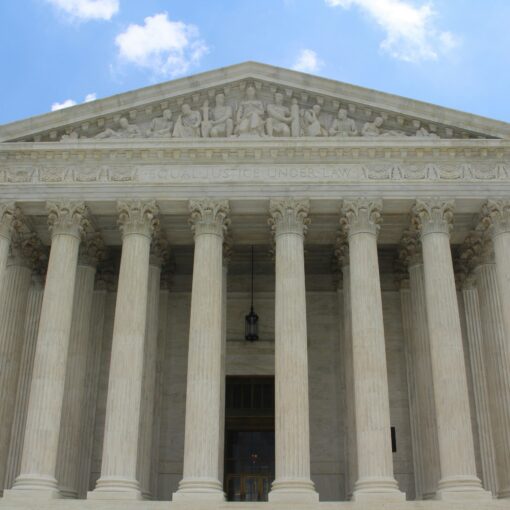 It has been more than a year and a half since the Securities and Exchange Commission (SEC) proposed its climate-related disclosure rule. In the interim, lawsuits in the ESG and regulatory space have constricted the SEC’s path to promulgating a final rule that will survive judicial review. This blog post explores how the litigation landscape has developed since the SEC proposed the rule, and discusses the implications of several developing cases and doctrines. Ultimately, the SEC will have to anticipate these types of legal challenges in finalizing a durable rule.
It has been more than a year and a half since the Securities and Exchange Commission (SEC) proposed its climate-related disclosure rule. In the interim, lawsuits in the ESG and regulatory space have constricted the SEC’s path to promulgating a final rule that will survive judicial review. This blog post explores how the litigation landscape has developed since the SEC proposed the rule, and discusses the implications of several developing cases and doctrines. Ultimately, the SEC will have to anticipate these types of legal challenges in finalizing a durable rule.
When the SEC initially proposed the rule, the Supreme Court had not yet embraced the Major Questions Doctrine (MQD), a new doctrine that constrains the function of the administrative state. Other legal challenges have also arisen. Judicial deference to agency decisions is on the Supreme Court’s docket this year, threatening the established practice of accepting an agency’s judgment in cases of statutory ambiguity. Additional cases raise questions about the scope of businesses’ First Amendment rights, along with instances of stringent arbitrary and capricious review under the Administrative Procedure Act (APA). Together, these matters suggest a volatile litigation landscape that the SEC will have to navigate thoughtfully as it finalizes and defends the climate disclosure rule.
The Major Questions Doctrine
The MQD has quickly become a popular deregulatory tool for conservatives, and its specter looms over environmental regulation efforts. Two recent cases of note have affirmed the use of the MQD. In the Supreme Court’s recent decision Biden v. Nebraska, the Court relied on the MQD to determine that the Biden Administration could not forgive $430 billion of federal student loan debt under a 2003 Act that had not been the basis for such a sweeping program before. The Court noted that the “Secretary had never previously claimed powers of this magnitude [under the Act]” and that the “economic and political significance” of the action was “staggering”. And in the Fifth Circuit’s Texas v. Nuclear Regulatory Commission (NRC), the court used the MQD in part to strike down an agency’s license for storage of nuclear waste, claiming that absent clear congressional authorization, the agency was meddling in an area of “economic and political significance” beyond its statutory authority. The Fifth Circuit is a popular venue for deregulatory actions because it is conservative, and it is a likely venue for a challenge to the SEC’s climate rule.
There is, however, a notable exception to this trend. While the decision has been appealed, a federal district court in Utah v. Walsh refused to find that a revision to the Department of Labor’s (DOL) Employment Retirement Income Security Act of 1974 (ERISA) rule implicated the MQD. The court reasoned that, as the agency had repeatedly revised this rule with little fanfare, the “‘history and the breadth of the authority that [the agency] has asserted’ does not provide a ‘reason to hesitate before concluding that Congress’ meant to confer such authority.”
How can the SEC manage this threat? Immediately after the SEC proposed to strengthen climate-related risk disclosures, scholars offered many analyses about how the SEC could avoid falling into MQD territory with the final rule, all grounded in its statutory authority. The SEC is authorized by Section 7 of the Securities Act of 1933 to mandate disclosure by registrants of specified information and “such other information … as the Commission may by rules or regulations require as being necessary or appropriate in the public interest or for the protection of investors.” 15 U.S.C. § 77(g)(a)(1). In granting the SEC its broad authority, Congress has “spoken clearly” on the issue of the SEC’s ability to promulgate rules as determined by the agency’s expertise, provided they are sufficiently justified. Further, the SEC has a history of requiring disclosure of environmental information dating back to the 1970s. It has specifically been regulating disclosure of climate-related financial risk since 2010; the proposed rule is a “standardized and enhanced” continuation of that practice. Accordingly, the rule should not be seen as unheralded, nor transformative of the SEC’s regulatory role protecting investors, maintaining fair, orderly, and efficient markets, and facilitating capital formation. Even still, the agency will have to be strategic about how it positions the rule within its congressional authority and past agency practice to dissuade unfriendly courts from being tempted by the MQD.
Agency Deference
A doctrine established in the Supreme Court’s 1984 Chevron case is up for review this year in a pair of cases, Loper Bright v. Raimondo and Relentless v. Department of Commerce. Chevron established a framework for courts to analyze agency action. Under Chevron, a reviewing court examines the statute under which an agency claims the authority to regulate, to see if Congressional intent is clear. If the intent is clear, the agency must conform to Congressional intent. However, if the court finds that the statutory language is ambiguous, and could have multiple reasonable interpretations, then the agency should be given deference, in acknowledgement of agency expertise. The cases before the Supreme Court now seek to repeal or narrow this “Chevron Deference.”
Chevron has fallen out of favor at the Supreme Court, but at the circuit level it is invoked frequently and offers a crucial framework for consistent analysis of agency actions. One study found that appeals courts applied Chevron to almost 75% of cases involving an agency interpretation of a statue, and that agencies were significantly more likely to prevail when Chevron was used (77%) than when a court applied no deference regime (38%). Revoking Chevron would have enormous effects across the federal bench even though the Supreme Court itself has ignored the doctrine in recent years.
In the Utah v. Walsh decision mentioned above, the federal judge employed a Chevron analysis and found in the agency’s favor. In contrast, the Fifth Circuit in Texas v. NRC declined to show deference to an agency’s interpretation (though the case may be headed for an en banc rehearing). The Fifth Circuit summarily discredited two past court decisions from sister circuits that accepted the NRC’s ability to regulate for temporary nuclear waste storage facilities that are not on the site of a nuclear reactor. The agency had been regulating such facilities for decades because persistent governmental inaction has resulted in an absence of permanent storage facilities for nuclear waste in the United States. The Fifth Circuit found that the other circuits were wrong to allow the agency to continue issuing these permits because they failed to perform textual analysis of the agency’s enabling statute and had taken the agency’s assertion for its authority to regulate.
If, in a post-Chevron world, courts are less willing to defer to agency precedent, even when other circuits have, the past actions of an agency would do little to bolster its future security in engaging in those same activities without explicit enumeration in the agency’s legislative authority. Depending on the outcomes in Loper Bright and Relentless, this could pose a problem for the SEC’s climate disclosure rule, which has a broad grant of statutory authority and a statute that does not explicitly enumerate the range of information the agency may make registrants disclose, even though it does contain an extensive list of statutorily mandated requirements. Recently, the SEC mandated that corporations disclose details relating to their cybersecurity, which is an emerging threat and is not enumerated anywhere within the extensive list from 15 U.S.C. § 77(g)(a)(1). This controversial regulation has no precedent, unlike the climate rule. If a reviewing court were to show no deference to past practice, nor a willingness to read the agency’s enabling statute deferentially, it could hamstring the agency’s ability to regulate. All is not lost without Chevron, as agency action has survived at the Supreme Court without it being invoked, but without Chevron enforcing judicial deference to agency interpretations at the circuit level, conservative courts are more likely to find that agency interpretations are overbroad or unreasonable. Whether it can be called a reappearance of nondelegation concerns (not explicitly seen in a case since the 1930s) or just mistrust of the administrative state, the result could be a dramatic curbing of federal agencies’ abilities to regulate.
Arbitrary & Capricious Challenges under the APA
Review of administrative rules is dictated by the APA, 5 U.S.C. § 706(2)(A). It can vary in stringency between a “hard look” or a less exacting form of scrutiny. Courts must “hold unlawful and set aside” those agency actions, findings and conclusions found to be “arbitrary, capricious, an abuse of discretion, or otherwise not in accordance with US law.” But in doing so, courts are held to a strict standard and may not impose extraneous requirements or substitute their judgment for that of an agency.
The SEC was dealt a setback recently by the Fifth Circuit in Chamber of Commerce v. SEC. The Court granted review of the SEC’s rule requiring registrants to report day-to-day share repurchase data once a quarter and to disclose the reason why the issuer repurchased shares of its own stock. The SEC believed this information would be useful to investors, but, according to the Fifth Circuit, it failed to adequately justify the costs of disclosure. The court found that SEC’s failure to point to a “genuine problem” of informational asymmetry that harmed investors was an error grievous enough to permeate the entire rule and subject it to review. It is worth noting, and will be discussed below, that the rule failed the Court’s arbitrary and capricious threshold even though it met the state interest test required under a First Amendment challenge. On the heels of this defeat, the SEC is also being sued in the Fifth Circuit over its recent private funds rule. While this case is in its early days, plaintiffs are employing the same logic that worked against the SEC in the share repurchase case.
This logic could hold true for at least parts of the SEC’s climate rule if the Court finds that the costs of further GHG emission disclosure cannot be justified, or that there is no true informational problem for investors that the SEC is solving. A large percentage of emissions are already reported publicly with verification requirements through the EPA’s major source emissions reporting program—although the method and format of reporting are not tailored to aid investor decision making—and will also be disclosed through the EU’s CSRD scheme and California’s new GHG disclosure laws. But, the other disclosure regimes many issuers have and will comply with also means that the costs of disclosing GHG emissions to the SEC is likely overblown by critics. In justifying its reasoning, the SEC may be well-served by highlighting its responsibility to harmonize and standardize the diversity of voluntary and mandatory climate risk reporting in the market within its statutorily-mandated purpose.
This stringent review is not the norm, as arbitrary and capricious review is generally a deferential standard, and even in unfriendly circuits the majority of agency actions survive review. The DOL’s ERISA rule also faced an arbitrary and capricious challenge and triumphed. Judge Kacsmaryk, who is a Trump appointee, found that the agency had adequately explained its updated position and replied to comments that directly spoke to plaintiffs’ concerns. The DOL also made clear revisions to the proposed rule that reflected the DOL’s responsiveness to commenters. The Court carefully reviewed the record and found that the DOL acted within the bounds of the APA, and that it had justified its reasoning sufficiently to survive review. This sort of unbiased review, even when the Court explicitly said it was “not unsympathetic to Plaintiffs’ concerns over ESG investing trends” suggests that cabined judicial review under the APA is still present and as such, the SEC’s climate risk disclosure rule could survive a challenge if it is clearly responsive to the comments received and shows that the agency did not act arbitrarily or capriciously.
First Amendment Challenges
Mandatory disclosures are a form of commercial speech, which receives fewer protections than general speech. Mandated disclosures, like the ones that the SEC is proposing for climate risks, are subject to rational basis review under the Zauderer standard. There, the Court said, “an advertiser’s rights are adequately protected as long as disclosure requirements are reasonably related to the State’s interest.” This has been cabined to extend only to mandated disclosures of “factual and uncontroversial information,” a limitation that may invite debates about the application of a higher standard set out by Central Hudson, which involves a four-part, intermediate scrutiny test for non-factual or controversial commercial speech. This is the background against which First Amendment challenges to disclosure requirements are situated.
The National Association of Manufacturers (NAM) recently intervened in a case against the SEC relating to public company proxy statements, which may have ramifications for the SEC’s climate rule. A proxy statement is a document produced by a corporation that is directed at shareholders and informs them about matters to be voted upon at the next shareholder meeting, among other things. The SEC requires that shareholder proposals be included in the proxy statement, even if they are from activist shareholders pursuing an agenda beyond maximizing corporate revenue. NAM claims that the SEC lacks authority to compel inclusion of shareholder proposals in proxy statements. NAM asserts that under Zauderer, activist proposals in proxy statements are not “purely factual and uncontroversial information” and they are “divorced from shareholder value creation” because the topics therein are often contentious, such as abortion and gun control.
NAM’s argument about the SEC’s authority rests on precarious textual ground, but the argument pertaining to compelled speech about “controversial” information merits discussion. Forcing the corporation to speak on such matters is, according to NAM, unconstitutional. If the court were to find in NAM’s favor and state that the SEC cannot force inclusion of shareholder proposals within a corporation’s proxy statement that address controversial or political topics, it could spell trouble for the SEC’s climate rule, as some judges could find that climate risk is controversial, or at least not factual, if they were willing to extend NAM’s specious logic. This could be particularly true for the more qualitative proposed disclosures about climate risks as opposed to disclosures about quantities of greenhouse gases (GHGs) emitted. However, in the SEC’s recent loss in Chamber of Commerce, the Fifth Circuit’s First Amendment analysis is encouraging: the Court held that rationale-disclosure laws are purely factual disclosures subject to Zauderer, no matter if the underlying topic is contentious. The court struck down the SEC rule in that case on arbitrary and capricious grounds, not First Amendment grounds. While the case the Fifth Circuit relied on to determine that rationale-disclosures are factual was granted certiorari, the Fifth Circuit made no gestures towards questioning its underlying logic in the recent opinion. Accordingly, NAM’s first argument looks weak, particularly in the Fifth Circuit where it is being tried. This bodes well for the SEC.
While NAM has not reached a decision on the merits, and the intervenor’s argument is unpersuasive, it is illustrative of First Amendment challenges being leveled at mandated disclosures with ESG-related content. The SEC’s climate rule could be viewed as analogous, but there are indications that courts may not be swayed by plaintiffs currently seeking to dramatically expand First Amendment protection for commercial speech.
Conclusion
In the time since the SEC announced its intention to require GHG gas emissions and climate-related risk disclosure from registrants, several notable cases have reshaped avenues for challenging the final rule. Many of these litigations are ongoing or headed for appeal, and the contours of the final rule remain uncertain. But no matter what the SEC does, it is likely to face a protracted legal battle when the rule is finally promulgated. Indeed, the rule is an appealing target for challengers seeking to limit government action and attempting to push legal boundaries in Administrative Law and under the First Amendment. The agency will have to be thoughtful in addressing these emerging legal risks as they justify the final rule, and responsive to doctrines that have recently been embraced by courts that threaten the reach of the administrative state.






